

Rchoetzlein. Knowledge organization is the problem of arranging and classifying what we collectively know as a society in ways that can be easily understood and communicated to others.

The issues addressed in this thesis include the representation and storage of knowledge, semiotics, ontology, classification, systems for knowledge organization, and the visualization and aesthetics of knowledge systems. The Quanta software system is presented as a generic framework for the integrated storage, organization and visualization of human knowledge in interdisciplinary contexts. Novel contributions are made to both technical and conceptual aspects of knowledge organization.
Technical contributions include a hypergraph structure for the storage and efficient representation of knowledge, comparative zoomable timelines for the visualization of events in time, circle packing with dynamic loading to visualize trees, and a distributed architecture and protocol for social knowledge systems. Semantic tools. TreeSheets. Protege Ontology Library. OWL ontologies Information on how to open OWL files from the Protege-OWL editor is available on the main Protege Web site.
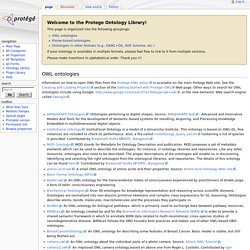
See the Creating and Loading Projects section of the Getting Started with Protege-OWL Web page. Other ways to search for OWL ontologies include using Google: or the new Semantic Web search engine called Swoogle. AIM@SHAPE Ontologies: Ontologies pertaining to digital shapes. Source: AIM@SHAPE NoE - Advanced and Innovative Models And Tools for the development of Semantic-based systems for Handling, Acquiring, and Processing knowledge Embedded in multidimensional digital objects. Frame-based ontologies In the context of this page, the phrase "frame-based ontologies" loosely refers to ontologies that were developed using the Protege-Frames editor.
Biological Processes: A knowledge model of biological processes and functions that is graphical, for human comprehension, and machine-interpretable, to allow reasoning. Other ontology formats. Stanford KSL Network Services. Mindmapping, concept mapping in 3D. MindManager, FreeMind and Personal Brain users.
Importing to 3D Topicscape Pro from MindManager, FreeMind and Personal Brain (and exporting to FreeMind) Personal Brain import Some of our early Beta Users were Personal Brain users, so from the beginning, we gave them a way of importing their information into 3D Topicscape. 3D Topicscape Pro can read .pba files (exported by Personal Brain Pro) directly and build you a 3D landscape of the information from the Brain, including the structure, all files and notes.
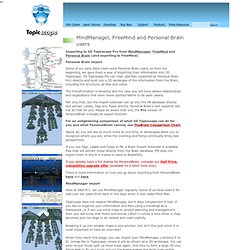
The transformation is amazing and the view you will have allows relationships and duplications that were never spotted before to be seen clearly. Not only that, but the import extender can go into the PB database directly and extract Labels, Tags and Types directly. Personal Brain's own exporter will not do that for you. For an enlightening comparison of what 3D Topicscape can do for you and what PersonalBrain cannot, see TheBrain Comparison Chart. Text 2 Mind Map - An online text to mind map converter. Ontology Matching. LOM: a linguistic ontology matcher based on information retrieva. GUESS: The Graph Exploration System, Download. Download If you would just like to run GUESS you have the option: Version 1.0.3-beta Install the latest beta (08/13/2007).
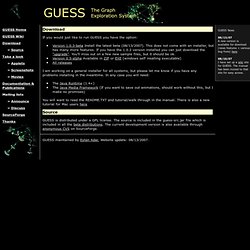
This does not come with an installer, but has many more features. If you have the 1.0.2 version installed you can just download the "upgrade". You'll miss out on a few new sample files, but it should be ok.Version 0.5-alpha Available in ZIP or EXE (windows self insalling executable)All releases I am working on a general installer for all systems, but please let me know if you have any problems installing in the meantime. RDF-Gravity. Sunil Goyal, Rupert Westenthaler {sgoyal, rwestenthaler}@salzburgresearch.at Salzburg Research, Austria RDF Gravity is a tool for visualising RDF/OWL Graphs/ ontologies.
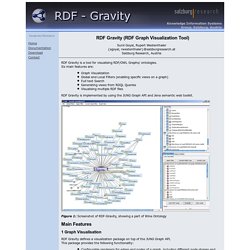
Its main features are: Graph VisualizationGlobal and Local Filters (enabling specific views on a graph) Full text SearchGenerating views from RDQL QueriesVisualising multiple RDF files. Conceptual Graphs Home Page. The TAO of Topic Maps. Finding the Way in the Age of Infoglut Table of contents Abstract Topic maps are a new ISO standard for describing knowledge structures and associating them with information resources.

As such they constitute an enabling technology for knowledge management. Dubbed “the GPS of the information universe”, topic maps are also destined to provide powerful new ways of navigating large and interconnected corpora. While it is possible to represent immensely complex structures using topic maps, the basic concepts of the model — Topics, Associations, and Occurrences (TAO) — are easily grasped. Note The original version of this paper was published in June 2000 and thus predates the development of XTM (XML Topic Maps). Since this paper deliberately avoids syntactical issues, the fact that there are now two standard interchange syntaxes for topic maps (HyTM and XTM) is not a problem.
Online Ontology Visualisation. Disco Hyperdata Browser. The Disco - Hyperdata Browser is a simple browser for navigating the Semantic Web as an unbound set of data sources.
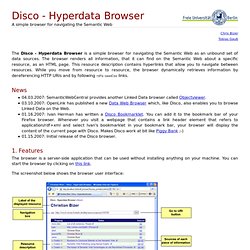
The browser renders all information, that it can find on the Semantic Web about a specific resource, as an HTML page. This resource description contains hyperlinks that allow you to navigate between resources. While you move from resource to resource, the browser dynamically retrieves information by dereferencing HTTP URIs and by following rdfs:seeAlso links. News 04.03.2007: SemanticWebCentral provides another Linked Data browser called Objectviewer. 03.10.2007: OpenLink has published a new Data Web Browser which, like Disco, also enables you to browse Linked Data on the Web. 01.16.2007: Ivan Herman has written a Disco Bookmarklet. 1.
The browser is a server-side application that can be used without installing anything on your machine.